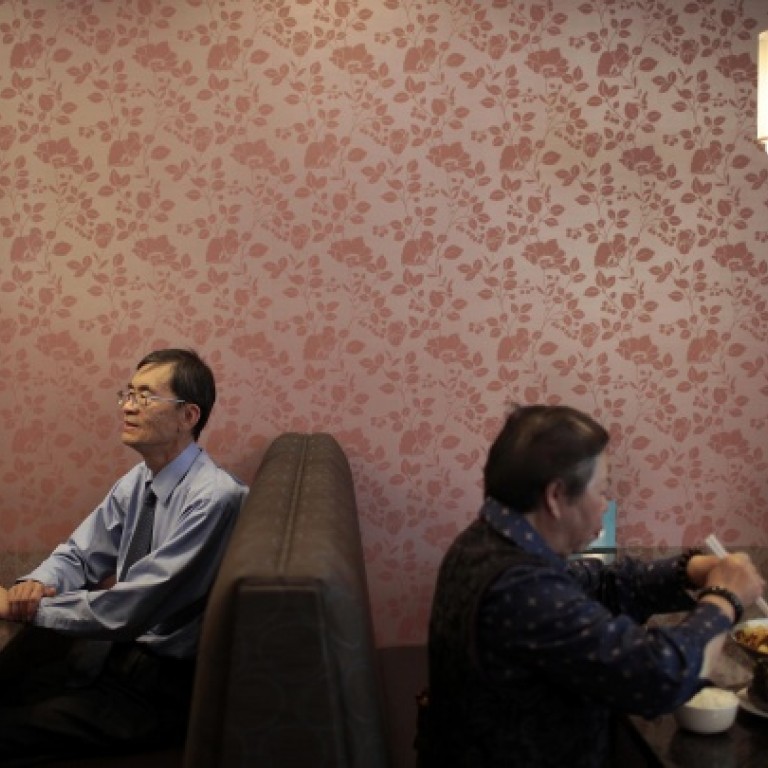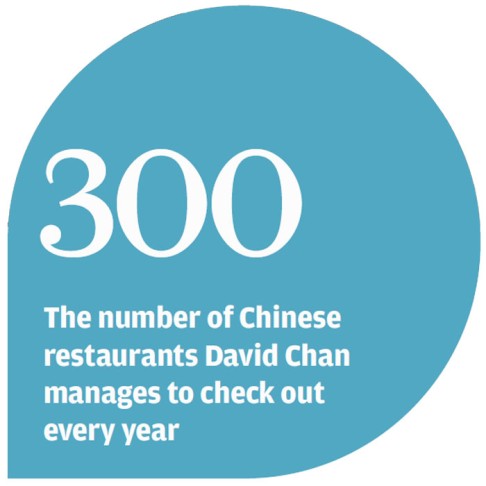
Lawyer David Chan has eaten at 6,300 Chinese restaurants in the US
Lawyer David Chan is renown for his gastronomic journey throughout the United States and adding to his growing list has become an obsession
The television cameras roll as Los Angeles lawyer David Chan places the first forkful of cashew chicken in his mouth.

Springfield cashew chicken is a local speciality and David Leong, the dish's 92-year-old inventor, was watching expectantly from across a table.
Chan kept chewing. The silence grew uncomfortable.
"How does it taste?" a reporter asked at last.
Chan didn't answer. The chicken was overcooked.
Finally, he spoke: "It's good," Chan mumbled diplomatically, and quickly grabbed seconds.
Chan, 64, has eaten at nearly 6,300 Chinese restaurants and he has documented the experiences on an Excel spreadsheet, a data-centric diary of a gastronomic journey that spans the United States and beyond.
A lawyer and accountant by trade, the slim, bespectacled man can debate Toronto's dim sum and rate Chinese buffets in Nashville. Name any neighbourhood in Los Angeles and Chan - with a few thoughtful blinks - will produce the name of a Chinese restaurant.
His expertise has brought him renown. Restaurant critics regularly ask him on Twitter for advice on where to eat. Food websites have sought him out to write about Chinese cuisine and its history. In Springfield, his lunch made the local news broadcasts - at 6pm, 9pm and 10pm.
Scrolling to the top of his spreadsheet takes you to 1955 and a different era in Los Angeles. The only Chinese food was in Chinatown, and food was his sole connection to his culture.
As a child, Chan hated Chinese food. The few times his parents would drag him to Chinatown restaurants like Lime House for banquets, he would sulk over a bowl of plain rice. Home-cooked dinners were American standbys like meatloaf and spaghetti.
If Chan didn't feel Chinese, it was partly by design. "I think my parents wanted to protect me," Chan said. "I was pretty much raised as an American."
Immigration quotas then allowed just 105 Chinese into the country each year, and only 8,067 Chinese lived in Los Angeles in 1950 - less than half a per cent of the city's population at the time, according to census records.
"Unless you lived in San Francisco, you were an oddity," said Chan, a third-generation Asian American.
His father graduated from the University of California, Los Angeles (UCLA), at the top of his accounting class, but the job offers from top firms never came. They lived in a neighbourhood that real estate agents had counselled them was "accepting of Chinese," and his parents never sent him to a Chinese school because they were afraid his English would suffer.
But Chinese food was always there, marking birthdays, weddings and graduations. While studying accounting and tax law at UCLA, Chan frequented a restaurant in a high-rise called Ah Fong's Westwood. It was the only Chinese restaurant in the area that he could recall.
After graduation, Chan took a job at a large accounting firm and befriended a group of co-workers from Hong Kong. He couldn't speak Cantonese with them, and he didn't know how to use chopsticks. But what he had in common with them was a love of Chinese food.
One day they went to lunch and ordered a dish of fried boneless chicken with crispy skin, lightly touched with a sweet-and-savory lemon glaze. It was like nothing Chan had ever tasted.
No215, 1984, dim sum and lemon chicken at ABC Seafood, 205 Ord Street, Los Angeles. A gray concrete corner lot with neon signage and faux-Greek entrance columns.
Lemon chicken was the product of a new wave of Chinese immigrants who flocked to the area around Los Angeles in the 1970s, lured by promises of a Chinese Beverly Hills in Monterey Park. Lush banquet halls serving Hong Kong cuisine suddenly proliferated across the San Gabriel Valley. Chinatown boomed.
Chan and his co-workers launched a lunchtime campaign to try every Chinese restaurant as it opened, amassing a trove of menus and business cards. Chan checked phone books for new restaurants. Adding to his list became a growing obsession.
"I've always been a collector. I collected stamps, and records," Chan said.
If his friends gave a poor review to a restaurant, Chan would eat there anyway. Perhaps they ordered the wrong dish, or the cook was having a bad day. He had to see for himself.
Chan was eating at new restaurants faster than they could open up. Soon there wasn't a single one in the area he hadn't tried, but still, he was not satisfied.
In 1985, he hit 86 restaurants in the Los Angeles area and around the country. The next year, 119. Before long he was trying more than 300 restaurants every year.
In Toronto, he hit six dim sum restaurants in six hours. When he travelled for business in Florida, he zigzagged the state to sample 20 Chinese restaurants.
Chan had always wanted to travel to all 50 states, and Chinese food gave him an excuse. In places he would have never imagined, he found Chinese people with their own Chinese food.
Chan rarely eats somewhere twice, but he keeps going back to ABC Seafood, even after the restaurant's ownership changed and, he said, the lemon chicken lost its flavour. Chan says he does it out of respect for history.
He's dined at practically every Chinese restaurant in Los Angeles, but few of them can match that first meal at ABC Seafood.
"For a good portion of when they were open, they were the best Chinese restaurant in the country," Chan said.
